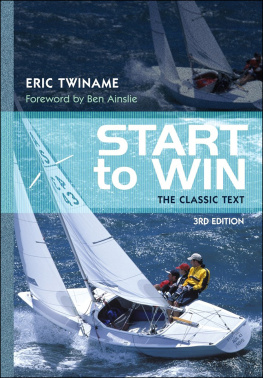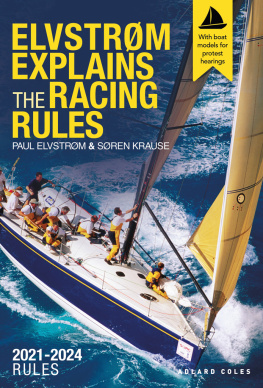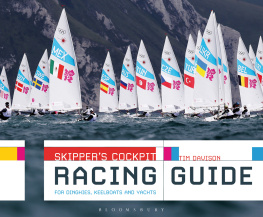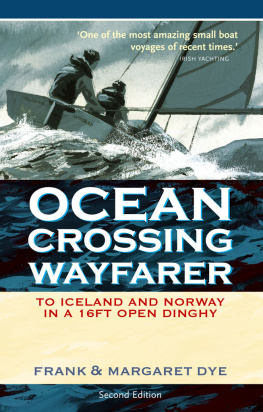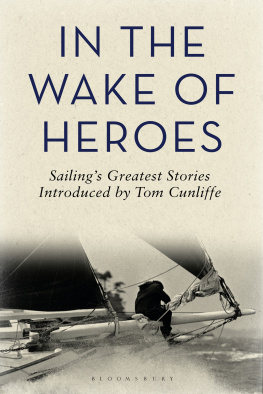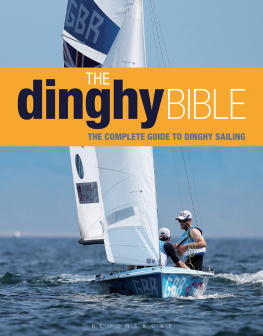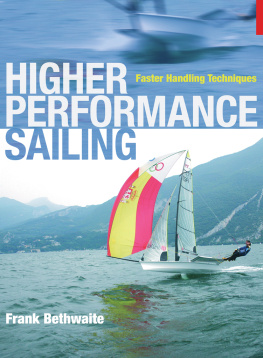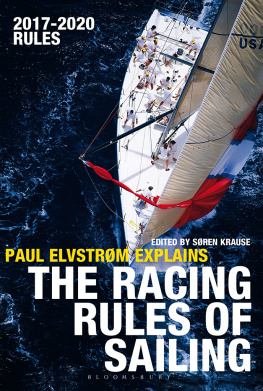
To Jill

Start to Win was first published in 1973, four years before I was born, yet by the time I had taken up dinghy sailing competition, some 14 years later, the book was still compulsive reading for all club helmsmen. The fact that it is now being republished 36 years after it was originally written speaks volumes about its instructive values and their still current relevance to racing dinghy sailing.
Apart from this book, one of four written by Eric, his legacy to sailing has been nurtured by the Trust set up in his name after his death in 1980, and which for nearly three decades now has been instrumental in providing funding and support for youth racing in the UK. There can be few current international dinghy sailors, myself included, who did not have their first introduction to competing in a large fleet at the RYA Eric Twiname Championship, the Trusts annual flagship event for all national youth classes.
It is therefore with great pleasure that I am able to support the Trust and the publishers, Adlard Coles Nautical, on their initiative in making this sailing classic available again in a very much refreshed and exciting format. It is written in such a clear, simple and practical manner that it cannot fail to be appreciated by all those club helmsmen who wish to better understand the principles and techniques of sailing but above all those who aspire to winning ways.
Ben Ainslie, CBE
Ben Ainslie, CBE, is Great Britains most successful Olympic sailor of all time, with a total of three Olympic gold medals and one silver. He is also nine times World Champion, three times ISAF World Sailor of the Year and helm for Team Origin, the British entry in the next Americas Cup campaign.
Photo Richard Langdon
Eric first crossed my bows during a team racing event on the Welsh Harp, ever since when he continued his winning ways to build up an enviable reputation as one of the UKs most talented dinghy sailors. In many ways his reputation was unique in that he established it in the hotbed of National competition and not on the International circuit where it is sometimes easier to build up a mystique. It is for this reason that this book is so valuable.
To my mind the real test of a sailor with a reputation as a great is his ability to pass on his knowledge to others. Erics many lectures and his first book, Dinghy Team Racing, now a standard work of reference, provide such proof of his talents.
This book was written for ordinary helmsmen whose time to experiment with new gear and try out new tactics is strictly limited, yet who are quite capable of winning, given the right sort of guidance.
Its excellence lies in Erics incisive approach; his insistence that theres no magic formula; that winning is a state of mind allied to a sound methodical approach.
He puts readers in the leaders position so that they have to determine the what, where and when of the next move. He interprets the language of the expert and takes the guess and the gamble out of tactics.
The text is complemented by the superbly selected illustrations; especially so in the Rules Guide which will do much to cut through the forest of confusion that has made the Rules so inhibiting to beginners and experts alike.
I commend this book to those who wish to gain more enjoyment out of their sport.
Bob Bond
RYA National Sailing Coach
Note: The original photos in this book are intrinsic to Erics instructive teaching and so for the most part have been retained.
We are grateful to Erics brother, John, for his magnanimous gesture in assigning the copyright of Start to Win to the Trust.
We are also indebted to Ben Ainslie for writing a Foreword. The Trust provided some modest funding for Bens first Olympic campaign in 1996 and it has been particularly gratifying to have been able to follow his subsequent development and success in the sport. He is truly an inspiration to the young sailors to whom the Trust aims to provide support.
Fellow trustee Bryan Willis has made a significant contribution to this third edition by not only reviewing references to rules in the general text but more specifically updating the chapters on rounding marks, protests and the racing rules, so that they align with the 20092012 ISAF rules.
Bruce Aitken has edited this edition on behalf of the Trust.
The Eric Twiname Memorial Trust
Some of the following material first appeared in a series of articles in Yachts and Yachting entitled Back to Front. The section about the gate start and some of the material in Chapter 2 first appeared in Yachting World. The ideas on protest technique and crewing also made their debut in Yachts and Yachting.
Many people helped me to put the book together and I would like to thank them. Yachts and Yachting and Yachting World generously allowed Carolyne Lougher, who did such a thorough job of the picture research, to sift through their picture collections. John Illingworth is the fall guy in the Laser sequences (he is the bearded one who always comes out worst). The London University sailing team of Alan Curran, Derek Clark, Ed Hyams, Robert Hyams, Nigel Allso and Mark Roskell provided the action in the Firefly and GP14 sequences, sometimes (as in the gybing capsize taken in mid December) going uncomfortably beyond anything they were supposed to do.
Without Dr Dave Hardwicks original suggestion of using a water model to simulate air flow round sails, the flow pictures would never have been taken; and without his help in the laboratory, they wouldnt have been so good. Arthur Barron patiently answered many niggling rules questions I put to him from time to time, and Reg Percival helped to check that in making such a radical re-arrangement of the rules, I hadnt also re-arranged their meaning. An understanding of the kinds of problems an aspiring helmsman has in learning how to win races came mainly from crewing occasionally for Margaret Redfern at Bassenthwaite Sailing Club. And most of all I have to thank Nigel Redfern for his painstaking criticisms of the original manuscript and the really good suggestions he made that were included in the final draft.
Eric Twiname, London 1973
This book is written for the benefit of ordinary helmsmen who may never race in the Olympics but do want to win their club races and perhaps one day their national championships. So emphasis is all the time on the skills and thinking of the man at the helm and his crew. In an age of technical wizardry there is always the let-out that were being beaten because the top man has better sails, mast, hull and equipment, when in fact he is a better helmsman who knows precisely what to do to get any boat round the course as fast as it will go. The race-winning tactics and ideas included here are not therefore limited to a few specialised classes; they apply to any dinghy that relies on crew weight for ballast ().

If the helmsman is good enough he can step into (or on to) any boat and win. The priority in learning to win is helmsmanship first, boat tune second.
Next page
